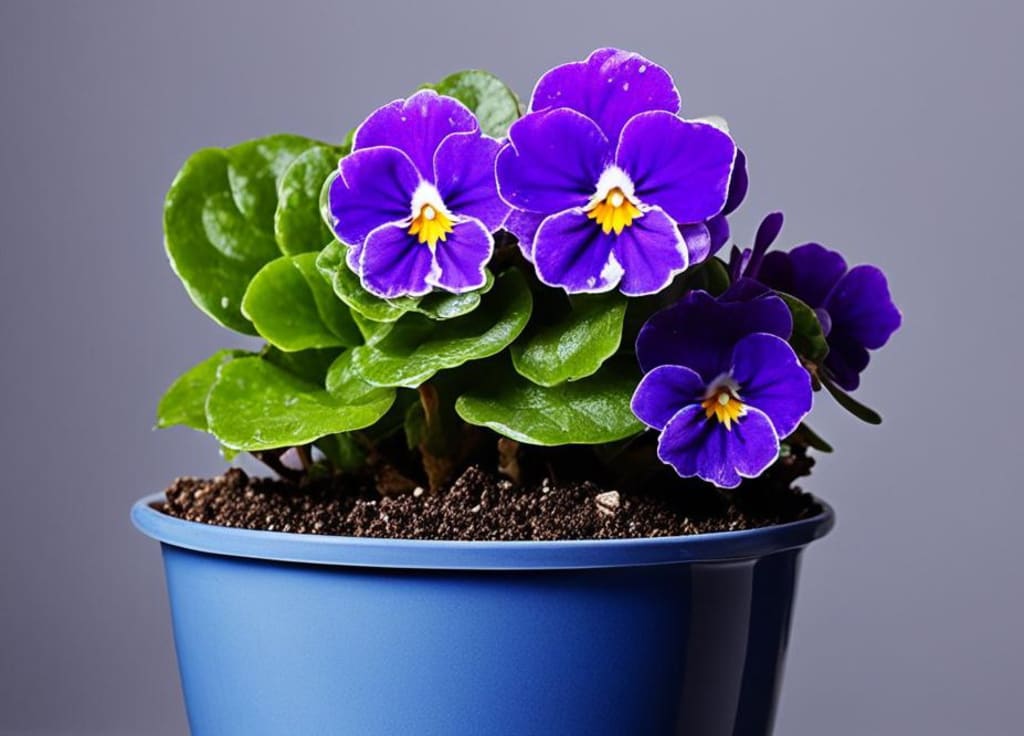Propagating African Violets: Easy Step-by-Step Guide
Mastering the Art of African Violet Propagation: A Simplified Step-by-Step Process

Gardening enthusiasts often find the process of propagating African violets to be a rewarding experience. With their lush leaves and vibrant blooms, these plants add a touch of elegance to any indoor garden. If you're new to the world of African violet propagation, fear not. Our guide is designed to make propagating an African violet a simple and enjoyable journey.
Whether you are a seasoned gardener or a beginner, learning how to propagate an African violet can transform your approach to indoor plant cultivation. So, let's embark on this step-by-step adventure and equip you with all you need to successfully propagate an African violet.
Key Takeaways:
● Simple steps to propagate an African violet for beginners and experts alike.
● An understanding of the propagation process, key to expanding your African violet collection.
● Expert advice for selecting the appropriate leaves and cuttings for African violet propagating.
● Practical tips to ensure the lush growth and blooming success of your propagated African violets.
● Techniques for nurturing your African violets through each stage of African violet propagation.
Understanding the Basics of African Violet Care
To achieve optimal African violet care indoors, it's crucial to create an environment that mimics their natural habitat. Light is particularly important; these plants favor bright, indirect sunlight. Placing them near a north-facing window provides them with the gentle yet ample light they need. Additionally, maintaining a consistent indoor temperature between 65 to 75 degrees Fahrenheit will keep your African violets comfortable and encourage their growth.
Essential African Violet Care Tips
● Watering: African violets prefer to stay moist but not waterlogged. Use room temperature water and avoid wetting the leaves to prevent spotting.
● Humidity: These plants enjoy a higher humidity level around 40-60%. A pebble tray or a small humidifier can help maintain the necessary humidity.
● Fertilization: Feed your African violets with a balanced fertilizer every 4-6 weeks to provide them with the necessary nutrients.
Choosing the Best African Violet Soil
The right soil is pivotal for growing African violets. An ideal African violet soil should be loose and well-draining to prevent root rot, while also being rich in nutrients to support plant growth. Below is a comparison table of two suitable soil types for African violets:
- The soil type is Commercial African Violet Mix, composed of peat moss, perlite, and vermiculite. It offers high drainage and a slightly acidic pH level, fortified with essential nutrients.
- The Homemade Mix soil consists of equal parts peat, perlite, and coarse sand. It provides moderate to high drainage and a neutral to slightly acidic pH level, potentially requiring additional fertilization.
Having the right soil ensures your African violets have the best foundation to promote healthy root systems, leading to vibrant and long-lasting blooms. Whether you choose a commercial mix or opt to create your own, ensuring proper aeration and nutrient balance is key in African violet care.
African Violet Leaf Propagation: A Detailed Guide
Propagating African violets can be deeply rewarding, offering a window into the cycle of life and growth. Leaf propagation, particularly African violet propagation in water, makes it possible to create new plants with patience and care. Here's how to achieve successful rooting African violets using water as your medium.
Selection of Healthy Leaves
Start by examining your African violet and choose a healthy, mature leaf. Opt for one that's full-sized, brightly colored, and free of damage or disease. The leaf's health is a precursor to successful propagation, as a robust leaf will have better chances to propagate African violet in water.
Preparing for Cutting
Cut the selected leaf at a 45-degree angle using a sharp, sterilized blade. This angle increases the surface area available for root development and helps promote better water absorption. Ensure the cut is clean to avoid any potential for infection that could damage the leaf during the rooting process.
Rooting Medium Setup
Fill a container with room temperature water, submerging only the cut end of the leaf. Avoid letting the leaf itself sit in water, as excess moisture can lead to rot. By setting up your rooting medium correctly, you encourage the leaf to develop roots without the risk of decay.
Here's a straightforward table to ensure you've got all you need for a successful propagation:
Step 1: Select a Healthy Leaf - This results in obtaining a robust leaf ready for propagation.
Step 2: Cut at a 45-Degree Angle - This action increases the surface area for rooting.
Step 3: Submerge the Leaf in Water - This creates a suitable environment for root development.
Monitor the water level regularly, keeping it consistent, and change the water every few days to maintain cleanliness. With attention and care, you will soon see roots sprouting—a subtle yet thrilling indication that you have mastered the art of African violet propagation in water.
The Benefits of Wick Watering for African Violets
When it comes to African violet care, maintaining the perfect balance of moisture can be quite the feat. Excessive watering can lead to root rot, while insufficient hydration can make these beautiful plants wilt. Fortunately, wick watering African violets offers a simple yet effective solution to this dilemma.
Understanding Wick Watering System
The wick watering system is a method that employs water wicking material to provide a consistent supply of water to the plant's roots. This is particularly beneficial for African violets as it mimics their natural environment's moist conditions, without the risk of waterlogged soil. By using capillary action, the wick draws water from a reservoir, ensuring the soil remains evenly moist and that your African violets receive just the right amount of hydration.
Setting Up Wick Watering with ACE Supply White Nylon String
To set up a wick watering system, you will need a container for the water, a piece of ACE Supply white nylon string, and a little know-how. ACE Supply white nylon string is a favorite choice among enthusiasts due to its longevity and excellent water wicking capabilities.
- Choose your container and fill it with water. The size should be appropriate for the number of plants you are watering.
- Thread the string through the pot's drainage hole. Tie a knot at one end to prevent it from slipping through.
- Place the other end of the string into your water container. Ensure that the string reaches the bottom to wick up water effectively.
- Secure the pot above the water container. You can use a shelf or a stand to ensure the pot does not sit in water.
With these steps, you will create a self-watering system that can keep your African violet watering regime effortless and precise. This process greatly simplifies how to water African violets and is an excellent method for consistent moisture without the guesswork.
- Benefits: Reduces risk of overwatering and underwatering.
- Considerations: Initial setup required.
- Benefits: Provides steady moisture to plants.
- Considerations: String must be kept clean to prevent algae growth.
- Benefits: Allows for easy care, especially during vacations.
- Considerations: Regular checks to ensure the water reservoir is full.
Embrace the simplicity and effectiveness of wick watering, and you'll soon see why so many African Violet enthusiasts are turning to this hassle-free, revolutionary African violet care approach.
How Often and How to Water African Violets
Providing your African Violets with just the right amount of water can be likened to an art form—a balanced act between care and precision. In this section, we'll distill the wisdom of experienced gardeners to help you master the watering routine, ensuring the vibrant health and flourishing of your African Violets. Understanding the frequency and methods for watering violets is paramount not only for propagation success but for the long-term vibrancy of your indoor garden.
Determining Watering Frequency
To pinpoint how often to water African Violets, observation is key. These plants prefer a consistent moisture level, where the soil is neither over drenched nor bone dry. The frequency can vary from weekly to bi-weekly, depending largely on the environmental humidity and temperature. Violets housed in warmer rooms may thirst for more frequent watering, while those in cooler conditions may fare well with less. Regularly assess the topsoil; a light dryness to the touch signals it's time to quench the plant's roots. Yet, always be cautious to not overdo it, as excessive enthusiasm in watering can lead to health issues for your violets.
Best Practices for Watering African Violets
Watering violets with lukewarm water is preferable, as extreme temperatures can shock their delicate root systems. When watering, aim to apply water directly to the soil, avoiding wetting the leaves which can cause unsightly spots or damage.
For many enthusiasts, the bottom-watering technique, where water is absorbed upwards from a tray, is a godsend, promoting even distribution of moisture without disturbing the foliage. Also, integral to best practices is the quality of water used; soft, dechlorinated water keeps your violets free from buildup that can hamper growth.
Common Mistakes in Watering Violets
Becoming overzealous with the watering can, or neglecting a routine check, rank high among the mis-steps gardeners might encounter. African Violets are prone to root rot when waterlogged, so ensure good drainage to avoid soggy conditions.
Likewise, irregular watering can lead to stress and disease. Implement consistency and be mindful not to leave water standing in saucers, as this can spell trouble for the root health. Culminating our discussion, avoiding these common pitfalls will put you firmly on the path to nurturing a thriving African Violet collection.
Frequently Asked Questions
What is the best method for propagating African Violets?
Leaf propagation is one of the most effective and popular methods for propagating African Violets. This involves selecting a healthy leaf, cutting it properly, and then placing it in a suitable rooting medium or water to encourage rooting and the growth of a new plant.
How do you care for African Violets indoors?
Care for African Violets indoors by ensuring they get moderate to bright, indirect sunlight, maintaining a consistent temperature around 65-75°F, avoiding cold drafts, and using a well-draining soil mix. It's crucial to water the plants carefully, using room-temperature water to avoid wetting the leaves, which can lead to rot.
What kind of soil is best for African Violets?
African Violets thrive in well-draining soil that is slightly acidic to neutral (pH 6.0-7.0). A specific African Violet potting mix is best, which usually consists of peat moss, perlite, and vermiculite. This mix ensures that the roots have access to the right balance of air and moisture.
How do I root African Violet leaves in water?
To root African Violet leaves in water, take a healthy leaf with a stem cut at a 45-degree angle, and place the stem in a container of room-temperature water. Make sure the leaf itself does not submerge. Use a transparent container to monitor root growth, changing the water frequently to prevent bacteria. Roots often appear within a few weeks.
What are the advantages of using a wick watering system for African Violets?
The wick watering system helps maintain consistent moisture levels for African Violets, which is crucial for their growth. It allows for self-watering, which reduces the risk of over or under-watering, roots rot, and other issues associated with improper watering practices. Using a wicking material such as ACE Supply white nylon string can enhance this system's effectiveness.
How often should I water my African Violet?
African Violets should be watered when the top of the soil feels slightly dry to the touch. Typically, this is about once a week, but it can vary depending on the humidity and temperature of your environment. It's vital to monitor the soil moisture and adjust the watering frequency accordingly.
Are there common errors to avoid when watering African Violets?
Yes, common watering errors include watering too frequently, leading to root rot, and using cold water, which can shock the plant's roots. Also, avoid getting water on the leaves, as this can cause unsightly spots and potentially lead to disease. Always use room-temperature water and aim to water at the base of the plant, near the soil.
About the Creator
Patricia
I am a writer, blogger and nature lover. I love to write on different topics.
Enjoyed the story? Support the Creator.
Subscribe for free to receive all their stories in your feed. You could also pledge your support or give them a one-off tip, letting them know you appreciate their work.






Comments
There are no comments for this story
Be the first to respond and start the conversation.